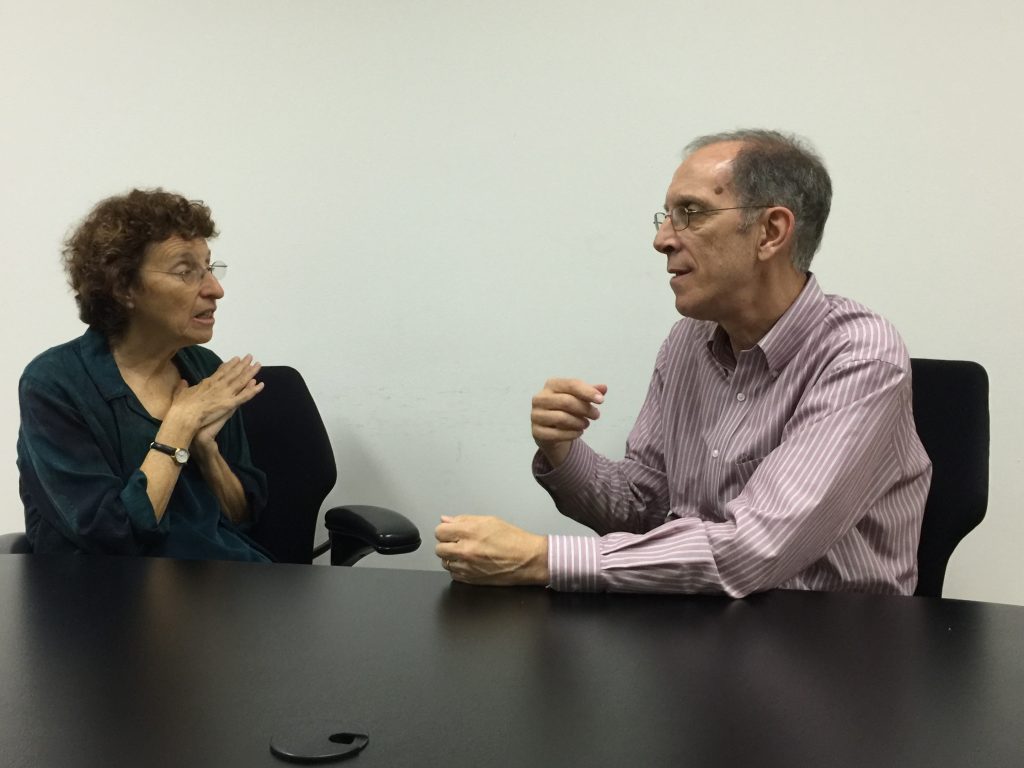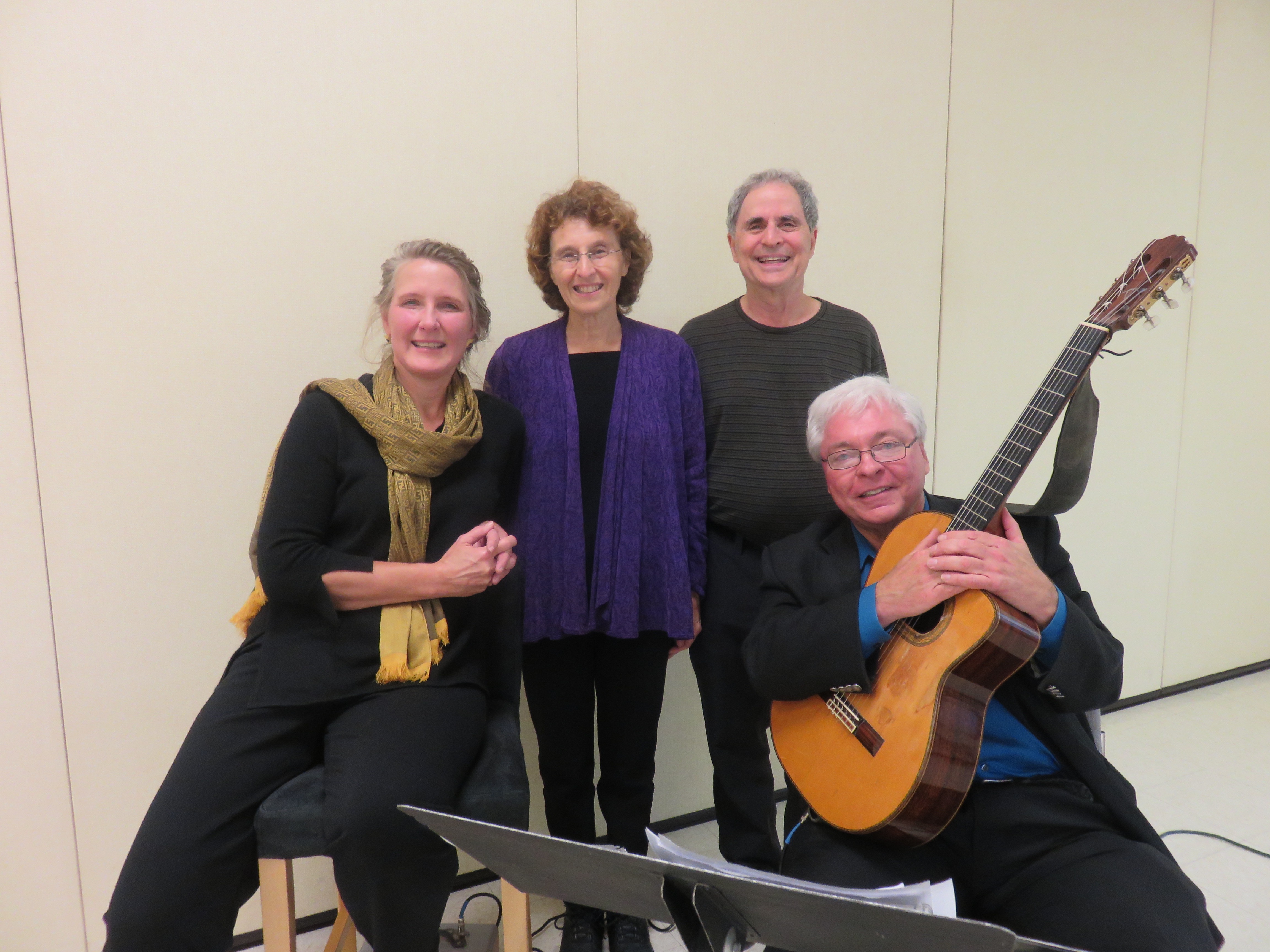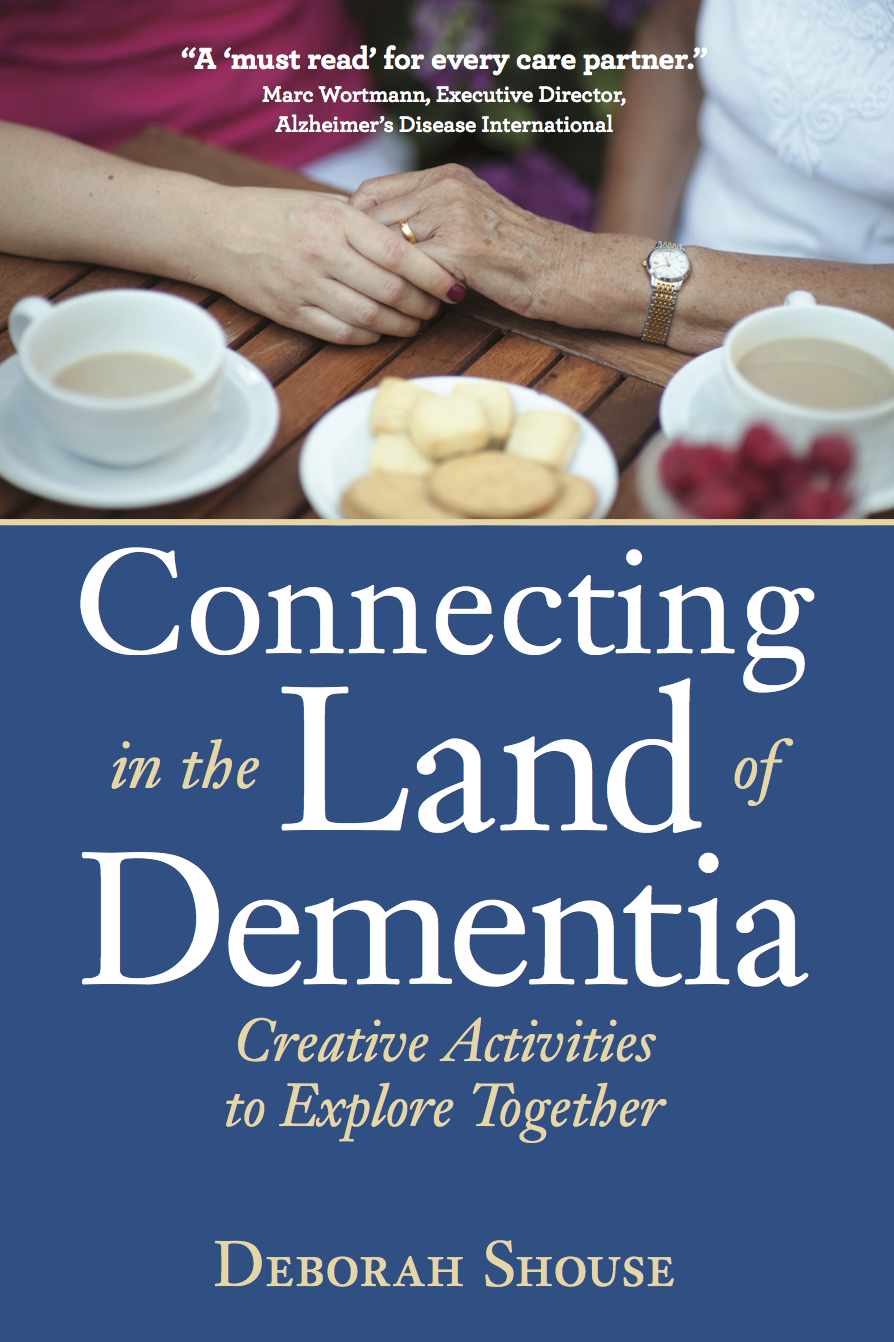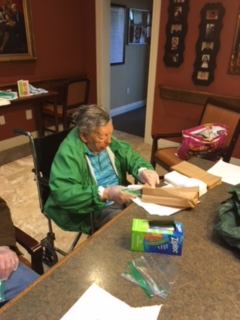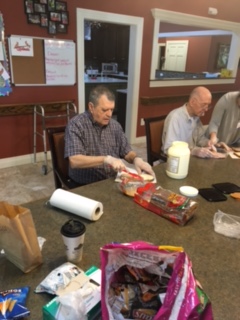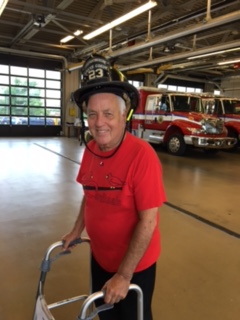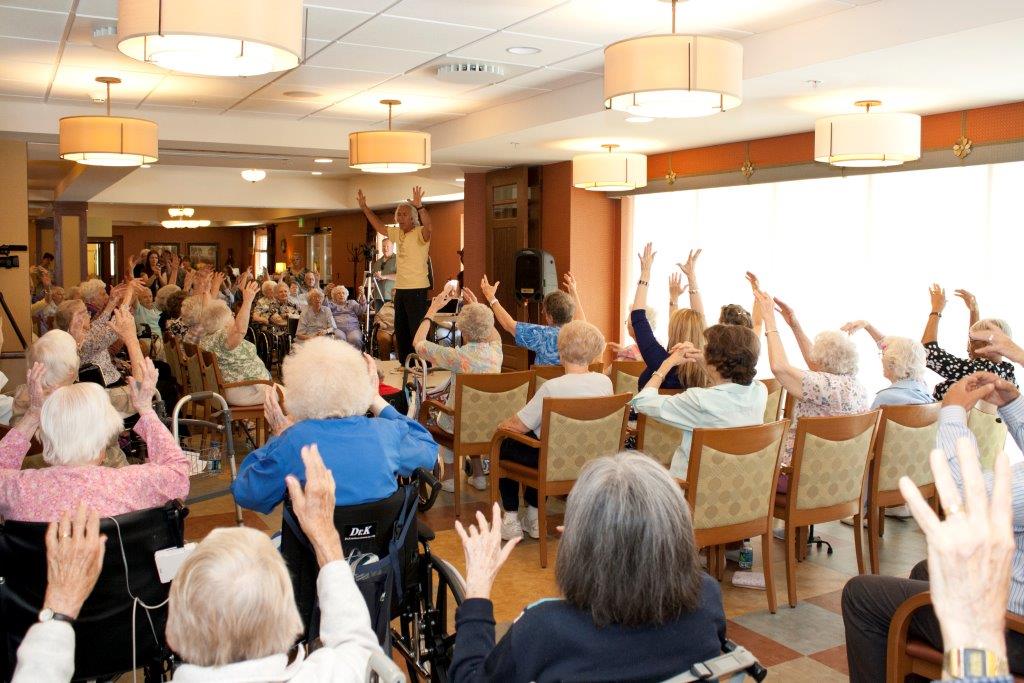Inspiration
The Power of the Playlist
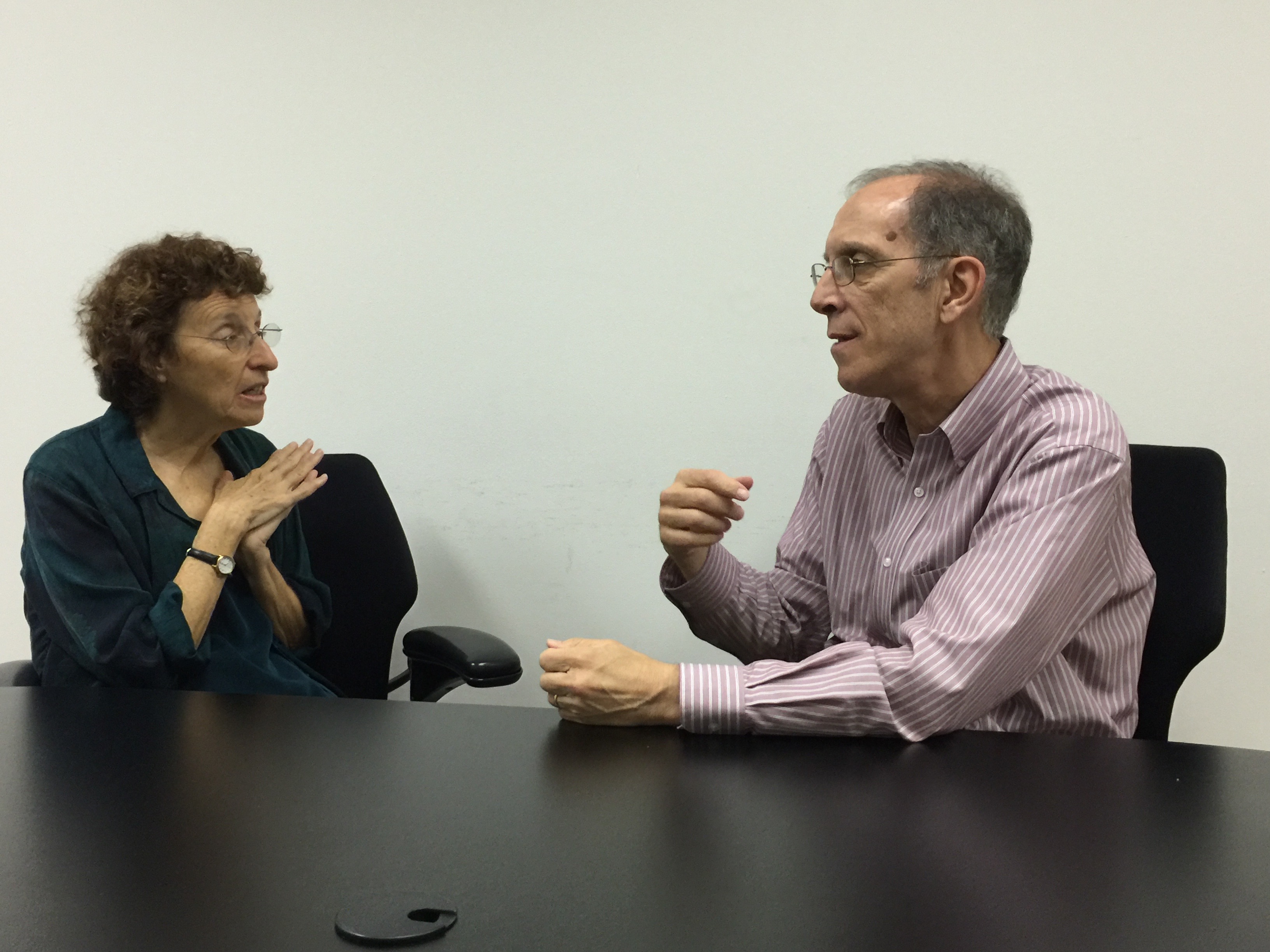 Ron and I were already champions of Dan Cohen’s world-changing Music & Memory program, which is featured in Connecting in the Land of Dementia, but we had never met Dan in person. The moment we learned we were going to New York City, we reached out to Dan and he agreed to meet with us.
Ron and I were already champions of Dan Cohen’s world-changing Music & Memory program, which is featured in Connecting in the Land of Dementia, but we had never met Dan in person. The moment we learned we were going to New York City, we reached out to Dan and he agreed to meet with us.
Dan is a prime example of one collaborative person making a difference for thousands. Eighteen states have already funded Music & Memory rollouts as a best practice approach for care facilities to improve quality of life for persons with dementia. In Toronto, everyone who is diagnosed with dementia receives a free iPod so they can enjoy personalized music. Dan and his team have trained 5000 dementia care managers, who understand how effective this program is. He is currently collaborating with hospitals, hospice, and prisons, as well as long term care communities.
Here is some of the wisdom he shared with us.
“We all need to create our personal play lists now,” Dan says. “Music makes any healthcare encounter better. Whether you’re waiting in the doctor’s office, going into the hospital, attending rehab, or moving into a care community, you’ll have a more comfortable experience when you are able to listen to favorite songs.”
Click here to listen to Dan Cohen.
Click here to learn more about the Music and Memory program.
Read more about Dan’s programs in Connecting in the Land of Dementia: Creative Activities to Explore Together. Order your copy from your favorite independent or online bookstore.
At Long Last: A Page-Turning Love Story
My hands trembled as I reached out my arms. For three long years I’d been working toward this meeting and yearning for this moment. Now, it was finally here. She was more beautiful than I had imagined, with a pleasing weight, just right for holding, just right for spending long hours with. From a glance, her personality seemed strong and purposeful and yet her warm, colorful exterior told me she would be easy to read. As she gradually opened up to me, I felt her power, her accessibility, her willingness to share ideas and wisdom. She felt great; she looked great; and she was brimming with exciting new ideas. Three long years and finally, she was in my arms. I hugged her tightly. At last I was holding my new book, Connecting in the Land of Dementia: Creative Activities to Explore Together
What makes this book unique? It’s the amazing people who contributed to it. During the writing process, I interviewed dozens of innovators across the globe, gathering ideas that engage the creative spirit so you can continue to experience meaningful moments throughout the dementia journey. These luminaries inspired me every step of the way and I am eager to share their ideas with you.
This book is brimming with easy projects using music, art, movies, cooking, gardening, and more. Here are some of the benefits you can look forward to when you do these activities together: Increased energy and socialization, an improved sense of purpose, reduced anxiety, and chances to express yourselves in new and meaningful ways.
Here’s even more good news about the ideas in this book. They’re adaptable for all ages and abilities, and you don’t need to have any special talents. Simply incorporate them into your daily routine and you’ll enrich your time together.
Marc Wortmann, Executive Director, Alzheimer’s Disease International, called the book “A ‘must read’ for every care partner because it really helps you to look at things differently!”
If you’re in the Kansas City area, please join us for the book launch on Sunday afternoon, October 9th, at 1:30 for a reception in the Truman Forum at the Plaza Library. The free presentation will begin at 2:00 This lively program, filled with ideas, stories, and songs, features myself and my partner Ron Zoglin, musical luminaries Rod Fleeman and Cynthia Schroer, and guest speaker Michelle Niedens from the Heart of America Chapter, Alzheimer’s Association.
RSVP 816-701-3407
For those of you in the Washington DC area, please join us at the free Alzheimer’s Foundation of America Caregiver’s Conference on Thursday September 29. We’ll be presenting there, along with other experts in the field. Click here to register.
We recently heard from several readers, saying, “This book is going to help so many people. I’m recommending it to my friends and colleagues.”
That’s what this is all about: enriching people’s lives through meaningful engagement.
It’s a challenge, bringing a new book into the world and we welcome your ideas and help in spreading the word about the book and the event.
You can order a copy now from Rainy Day Books, our book-seller for the event, or online.
Here is some advanced praise:
“A thoughtful and positive guide to the very thing I find myself constantly advocating to doctors, caregivers, and family members—social stimulation and creative arts will limit the need for psychiatric medication and improve the quality of life for those with dementia more than anything else.” Doug Wornell, MD, Life Solutions Group for Geriatric and Neurological Psychiatry
“Buy this book, read it, highlight what inspires you. As you make notes and bend pages to personalize this guide, you are creating a family treasure.” Carol Bradley Burdock, Founder of Minding Our Elders
“Deborah Shouse provides a great public service by shining light on the numerous creative activities that can meaningfully engage the minds and spirits of persons living with dementia. From personalized music to storytelling, Shouse makes it easy for caregivers to understand the various options they have to help their loved ones navigate through their everyday lives.” Dan Cohen, MSW Founding Executive Director, MUSIC & MEMORYsm
Tips from a Parisian Artist
 There’s something magical about visiting an artist in his studio. Especially if that studio is in Paris. We were honored to meet Patrick Laurin, artist and art therapist, on a recent trip to France.
There’s something magical about visiting an artist in his studio. Especially if that studio is in Paris. We were honored to meet Patrick Laurin, artist and art therapist, on a recent trip to France.
In the beginning, Patrick Laurin’s work with people who were living with dementia went slowly. When he first visited the care home and invited people to join him for painting, he heard various reasons the idea wouldn’t work. “I can’t hear you.” “I can’t see you.” “I can’t move my arm.”
 Patrick, who had quit working as researcher in the pharmaceutical industry so he could create deeper connections with clients, understood the importance of building relationships. Gradually, he got to know the people who lived in the community. He wanted to tailor an artistic experience specific to each person’s abilities and needs.
Patrick, who had quit working as researcher in the pharmaceutical industry so he could create deeper connections with clients, understood the importance of building relationships. Gradually, he got to know the people who lived in the community. He wanted to tailor an artistic experience specific to each person’s abilities and needs.
Over time, the people who couldn’t see, hear, or move were all happily involved in painting.
One woman seemed to blossom when holding the brush and stroking on the paint. Even though she couldn’t later remember to say, “I’ve been painting,” she enjoyed the experience.
One day, Patrick was on another floor in the care community when he encountered this woman and her daughter.
Her daughter said to Patrick,” You are the painter.”
Patrick was thrilled her mother had been able to mention the art therapy sessions. But before he could respond, the mother said, “No, the painter is me.”
“Inside, she was seeing herself as an artist,” Patrick says. “The painting strengthened her identity.”
 Patrick has learned to approach each person with flexibility. Sometimes Patrick jump starts his artists with a squiggle of color on the page. Then he steps back to let them respond with their own squiggle. If they’re stymied, he offers a choice of two colors.
Patrick has learned to approach each person with flexibility. Sometimes Patrick jump starts his artists with a squiggle of color on the page. Then he steps back to let them respond with their own squiggle. If they’re stymied, he offers a choice of two colors.
He also uses collage techniques to inspire his artists. He selects three separate pictures, each with one recognizable thing, such as a house, tree, or dog. He shows the photos to the artist, and asks, “Which one of these attracts you?” When the artist chooses a photo, Patrick then asks, “Where would you like to put this on the paper?” He and the artist apply paste to the paper.
“We don’t turn over the picture and apply paste, because the image then disappears and that can be confusing,” he says.
When the picture is glued to the paper, Patrick discusses a color that’s already in the picture.
“You could take the blue in the sky and extend it,” he might suggest. This suggestion often inspires the artists to start painting. If they get stuck, Patrick says, “What might look good near the house?” In this way, the painting expands.
For one woman, painting began as a series of colors and grew into a personal story.
She pasted a house and began expanding the lawn. Then she drew a bridge and weeks later, she added in a dog. At first, she was painting “a house, a bridge and a dog.” As the picture took shape, she said, “This is my house and my dog and this is the bridge we had to cross to get to the house.” The process of painting had loosened memories of her childhood home.
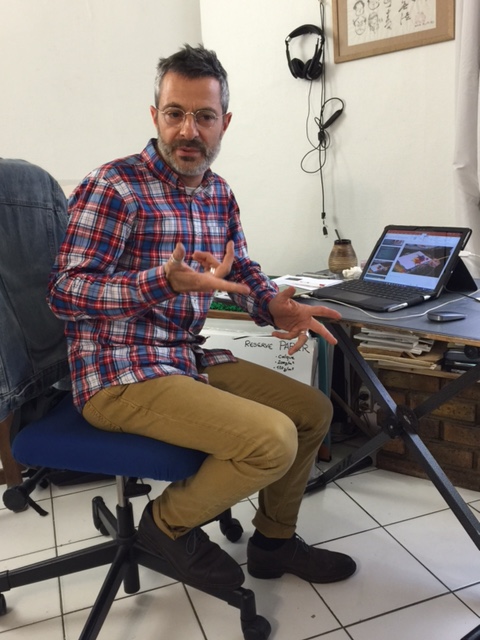 “When I share a piece of art by one of my students, I also share the story behind it,” Patrick says. “The act of creation is more important than the results.”
“When I share a piece of art by one of my students, I also share the story behind it,” Patrick says. “The act of creation is more important than the results.”
Tips:
Pick something that is easy for you, the care partner.
Put a point of color on the pages, then stand back. Offer support but don’t paint.
Enjoy the process and don’t get stuck on the results.
Thanks to Berna Huebner, founder of the Hilgos Foundation and co-producer of the documentary, “I Remember Better When I Paint,” for suggesting we meet with Patrick.
Get Cooking on Giving Back
The assembly line stretched around the spacious dining room table and each person focused fully on his task. One man spread mayonnaise on bread. Another placed turkey slices and another added cheese. Another slipped the sandwich into a baggie and others assembled the lunches, adding potato chips and a cookie. All worked diligently; there was a special purpose to this meeting of the Men’s Club at Dolan Memory Care Homes in Creve Coeur, Missouri. They were giving these homemade meals to the fire fighters in their community as a way of showing their appreciation.
Ten residents of varying abilities, including all levels of memory impairment, contributed to the sandwich brigade. Those who needed help had an assistant with them.
“The participating residents were filled with high energy and good spirits,” says Mary Kate Halm, LMSW, Admissions Coordinator of Dolan, who organized the activity. “They were excited to be engaged.”
The local fire department had invited the group to tour the station when they delivered the lunches. The experience included opening up the sides of the fire truck. One of the residents, who was usually indifferent to outings, used to be a tool designer. When he saw the tools in the fire truck, his eyes grew wide and he became very animated.
“Everyone enjoyed being engaged in a purposeful activity. They loved the tour and they asked excellent questions,” Mary Kate says. They wanted to know the details of their training, how much each truck cost, how much their equipment weighed, and more. The residents weren’t the only ones engaged.
“The firemen loved the attention,” Mary Kate says. “Plus, they were patient, communicated clearly, and were considerate of those in walkers and wheelchairs.”
The community volunteer activity generated a lot of joy and curiosity.
“They were completely connected to the experience,” Mary Kate says. “They were learning, they were giving back, and they were fully present. We created a moment of joy and that’s all that matters.”
Get ready to give back:
Mary Kate offers these tips for connecting with the community and giving back.
- Look for a service organization that you admire. This can be emergency responders such as fire fighters, police, sheriffs, EMTs, as well as animal rescue teams, cancer support organizations, and more.
- Find a project that’s fun for you and for the person living with dementia, a project you can both participate in. If you have friends and family who’d like to help, this is a great time to get others involved.
- Coordinate with the organization and find a time to deliver your gifts. If it’s of interest, ask for a chance to learn more about the organization.
For more interesting activity ideas, visit https://t.e2ma.net/message/gxreo/4bbql
Three Marvels of Misplacing
“These days I am constantly losing things,” a friend tells me. I understand, because I frequently misplace objects and even words!
“I don’t know where my glasses are,” Mom tells me. I bite my lip; she’s been misplacing things all day. We are supposed to be spending a day drawing and painting, trying to connect mom with the artist she used to be. We are supposed to bake cookies together and look through magazines. But I’ve been spending much of the time crawling around, looking under the sofa and chairs and between the cushions for the disappearing glasses.
“Let’s make our cookies. You won’t need your glasses for that,” I say.
“I need my glasses.”
As I search, I wonder when it became a drudgery instead of a joy to find things. One of my favorite childhood games was Hide ‘N Seek. I loved being the Seeker, loved the surprise of finding someone in a tucked away, mysterious place. I had a special trick I used when I was “It.” I would close my eyes and say, “If I were Dan, where would I hide?” Then an image floated into my mind and I’d race to the hiding place. Half the time, I was right.
Do I still have “it?” I close my eyes and think, “If I were Mom’s glasses, where would I be?” The refrigerator comes to my mind. I rush into the kitchen and fling open the refrigerator door, only to see the usual chaos. But I’m hungry, so I reach for an apple. Behind the fruit is a pair of reading glasses, sprawled across the shelf.
Triumphantly, I take the glasses to Mom.
“These feel nice,” she says.
Not only has my mother reminded me of the importance of creativity, curiosity and play, but she also discovered a great summer time tip: chill your glasses and cool off your face.
Deborah Shouse is the author of Love in the Land of Dementia: Finding Hope in the Caregiver’s Journey.
COMING SOON: CONNECTING IN THE LAND OF DEMENTIA: CREATIVE ACTIVITIES TO EXPLORE TOGETHER
Click for Poetry and Help Hundreds
My friend Molly has an exciting opportunity to expand the creative work she is doing with those who are living with dementia. She’s in the running for a small business grant from FedEx. Read this blog to learn more about the meaningful projects she is doing. If you are as inspired as I am, simply click on the link and vote for Molly and Mind’s Eye Poetry: http://bit.ly/1TgpDuJ
A brief silence unfolds while people consider.
“I used to wrap a scarf around my head in the convertible,” one woman says.
The woman sitting next to her smiles. “Scarves blow in the wind,” she says.
Molly mimics the scarf wafting in a breeze.
“If the scarf was music, what kind of music would it be?” Molly asks.
“Jazz,” a man says.
“Rock and roll.”
“Classical.”
Molly, who has an MFA and is the creator of Mind’s Eye Poetry in Dallas, Texas, reaches into her suitcase and brings out a small watering can. She continues the relaxed pacing, asking for impressions, invoking imagination, creating a sense of comfort and connection for this group of people who live in a memory care facility.
After 20 minutes of creative play, Molly takes out a slim book and says, “Here’s a poem about spring that I really like. See what you think.”
She reads the short, rhyming verse and asks for reactions. She then invites the group to contribute to a writing project.
“There are no wrong answers,” she assures them. “I’ll ask something and you’ll say the first thing that comes into your mind. For example, when I say ‘springtime’ what flowers do you think of? ”
“Daffodil, tulip, roses…” the group offers.
Molly writes down each flower and reads it back to the group.
“We have our first line of poetry,” she tells them.
“Imagine where the flowers are, in a vase, in the garden?”
“What colors are they? What time of day is it?”
Every question invites imagination and word-by-word, the poem emerges. After they’ve created three short poems, Molly shows them a piece of art and asks, “What do you see?” She captures their observations and uses their words to create a poem.
Here’s an example of a poem segment created after looking at Oriental Poppies, Georgia O’Keefe’s painting of two large orange poppies.
I see two evening gowns
on a diagonal, flowing.
I see a Scottie dog
prancing in a field of orange.
I see summertime in Santa Fe.
I see a black bird soaring into sunset.
“When I read back their words and say, ‘You all just wrote this,’ it’s very empowering,” Molly says.
For those at home who want to have a session of creative imagining, Molly has these suggestions:
Gather a few interesting objects, such as a recipe book, a nature photo, a pot holder, and one at a time, show them to your partner and ask, “Mom, what do you think about when you see this recipe book?” Give her plenty of time to respond and jot down her answers. If she asks, “Why are you writing?” tell her, “I value what you have to say.”
Soon, you’ll have a collection of words and phrases. You can take a photo of the object along with the poem it inspired and put them together in a book. #
Molly Middleton Meyer is the founder of Dallas-based, Mind’s Eye Poetry. To date, she has facilitated over 600 poems written by people with dementia. Mind’s Eye Poetry has been featured in U.S. News and World Report, the Huffington Post, the Dallas Morning News, Affect Magazine, Growing Bolder Magazine, and on NPR. When Middleton Meyer is not facilitating poetry, she writes her own. Her first book of poetry, Echo of Bones was published in 2014. For more information, contact Molly Middleton Meyer, M.F.A. Poetry Facilitator/Speaker at www.mindseyepoetry.com
Deborah Shouse is the author of Love in the Land of Dementia: Finding Hope in the Caregiver’s Journey.
COMING SOON: CONNECTING IN THE LAND OF DEMENTIA: CREATIVE ACTIVITIES TO EXPLORE TOGETHER
Dementia Café: Connecting through Donuts and Baseball
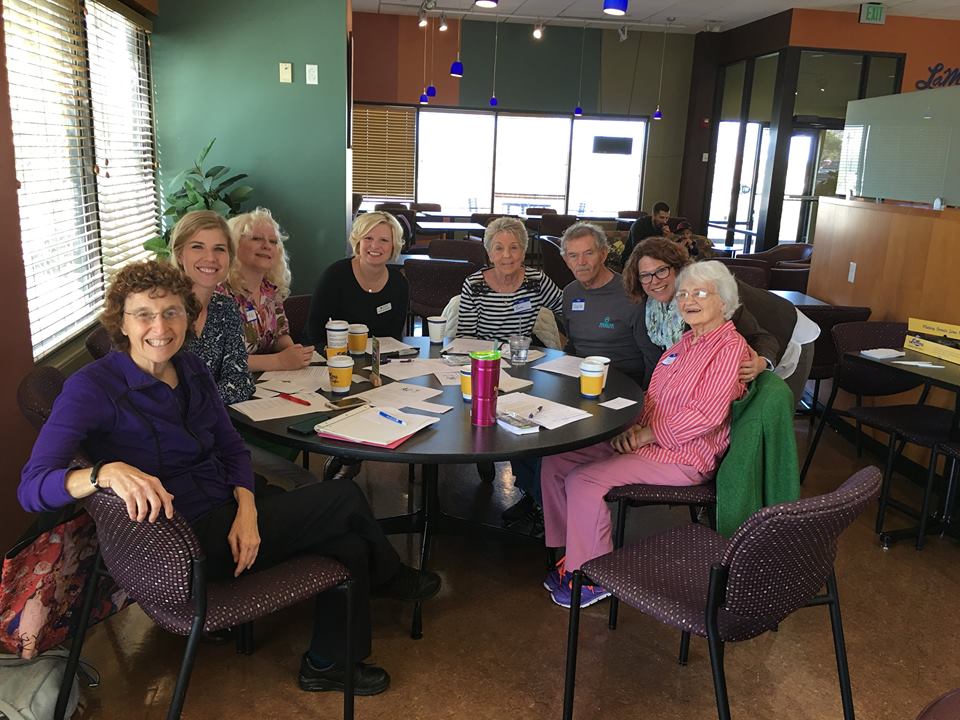
I’ve always enjoyed gatherings of creative people, so I was excited when I learned that Mandy Shoemaker was orchestrating a Dementia Café in our area. The premise is simple and fun: a group of people living with dementia, their care partners, and friends get together in a public space for a facilitated time of conversation, sharing, and creativity.
Mandy’s café took place in Lamar’s, a locally esteemed donut shop with a quiet atmosphere and a spacious seating area. Eight of us gathered around a table and Mandy opened the conversation by showing us a black and white photo of a baseball player laying on a field, next to a fence, apparently knocked out.
“Babe Ruth,” she told us. “He was running backwards to catch a ball and crashed into the barrier.”
We all nodded in sympathy, then began sharing baseball stories. Charlie had played in his youth and he and his wife Barb were ardent Royals fans. Courtney had played softball in high school. Fran, who grew up in the 1930’s in rural Mississippi, never had a chance to play sports but she liked hearing about the game.
“Did you ever listen to baseball on the radio?” Mandy asked her.
“In those days, not everyone had everything,” Fran said. “I don’t think we even had a radio.”
Barb remembered being on her grandparent’s farm, huddled around the radio, listening to the Yankee’s games.
“Have you ever heard the poem Casey at the Bat?” Mandy asked.
“I memorized it at school,” Charlie said.
 We took turns reading the dramatic poem, discussing such vivid terms as “when the dust had lifted” and “Casey lightly doffed his hat,” and one ball player was a “lulu” while another was “a cake.” The tension built and we chanted the last verse together. (Seek out this poem if you want to know what happened in Mudville that day: www.baseball-almanac.com/poetry/po_case.shtml )
We took turns reading the dramatic poem, discussing such vivid terms as “when the dust had lifted” and “Casey lightly doffed his hat,” and one ball player was a “lulu” while another was “a cake.” The tension built and we chanted the last verse together. (Seek out this poem if you want to know what happened in Mudville that day: www.baseball-almanac.com/poetry/po_case.shtml )
We then created a group poem, each contributing an answer to “Baseball is…”
I left the café feeling exhilarated and connected. Baseball was a catalyst for a great conversation that included life in the 1930s, family origins, Memphis, Elvis, baseball cards, Abbott and Costello, poetry, women and sports, fathers, hard work, radio programs, and more.
“It is our goal to create a more dementia-friendly community,” Mandy says. “Part of that is creating safe places for people with dementia to come and be a part of a group, with no expectations. The café invites people to just get out, be creative, and have fun.”
The KC Memory Café will meet on the second Tuesday of each month. To keep up to date, follow our facebook page at www.facebook.com/KCMemoryCafe
Create Your Own Cafe
You can also create your own café for two or more. Here are a few tips:
Select a public meeting place that serves refreshments and is reasonably quiet.
Let go of expectations and create a supportive atmosphere. You are here to express yourselves and connect.
Pick a broad topic that you are both interested in. Examples include seasons, sports, nature, games.
Start with a visual stimulation, such as a photo. Ask open-ended questions that invite imagination, such as “What do you see in this picture?” or “What do you think is going on?”
Allow the conversation to flow. The topic is a mere catalyst for ideas and communication.
Print out a familiar poem to read together. Enjoy the drama of reading aloud and invite comments on the poem.
For more about starting a café, visit
http://www.alzheimerscafe.com/public.html.alzheimersatoz.com/Welcome.html
Deborah Shouse is the author of Love in the Land of Dementia: Finding Hope in the Caregiver’s Journey.
COMING SOON: CONNECTING IN THE LAND OF DEMENTIA: CREATIVE ACTIVITIES TO EXPLORE TOGETHER
Three Tips for Celebrating Mother’s Day When your Mom Has Dementia
“I don’t know what to do about Mother’s Day,” a friend recently told me. “I used to celebrate with my mother, but Mom doesn’t really recognize me now and the holiday won’t mean anything to her.”
My friend was not alone in her dilemma: according to the Shriver Report, ten million women either have Alzheimer’s or are caring for someone with it.
I’d faced the same issue with my mom as she sank into Alzheimer’s. But I’d decided that celebrating Mother’s Day was important for me and for my family, even if Mom didn’t truly understand what was going on.
Here are three tips I devised for reducing the sadness this holiday can trigger and for substituting a celebration of renewal and connection.
Feel Your Frustration and Grief
The happy-family-candy-and-flowers Mother’s Day television commercials seemed to shout at me: “Your mother is no longer who she used to be!” That was true and a spike of sorrow stabbed at me as I mourned my “normal mom.”
Celebration: Talk about your feelings with empathetic friends; feel your grief and the frustration. Explore ways to express yourself, perhaps through journaling, collaging, stomping about. Or cocoon and immerse yourself in mournful movies and music.
Activate Your Appreciations
My mother could not complete a sensible sentence, cook a simple meal or dress herself. She did not know my name or remember any of my accomplishments or stellar qualities.
Celebration: Notice and appreciate the good in your situation. Even though Mom didn’t remember my name, she also didn’t remember any of my shortcomings. She was no longer critical of my parenting skills and no longer shy to show affection. She had a dazzling smile, a whimsical giggle and an ability to look into my eyes. She was content with who I was, whoever I was. These were qualities to celebrate.
Celebrate Yourself and Your New Relationship
Since my mom could not care for herself, I learned to care for her. Our lives wove together and we became deeply connected, as I emerged from being just a daughter to becoming an advocate, spokeswoman and historian for my mother.
Celebration: On Mother’s Day, I stopped to celebrate myself, my flexibility, my sense of humor, my steadfast feelings of responsibility. I gave myself the gift of time and appreciation.
7 Ways to Concoct a Creative Celebration
Share favorite memories
Tell her favorite life stories
List her opinions, maxims and worries
Sing along to favorite family music
Muse over family photos
Serve up easy comfort foods
Share what you’ve learned from your journey with her
Deborah Shouse is the author of Love in the Land of Dementia: Finding Hope in the Caregiver’s Journey. COMING SOON: CONNECTING IN THE LAND OF DEMENTIA: CREATIVE ACTIVITIES TO EXPLORE TOGETHER
An Insider’s Tips for Finding Joy in the Journey
“Alzheimer’s can be a grind,” a caregiver recently told me.
That’s one reason I am constantly seeking those who see the creativity and potential in the journey. I look for inspiration and I found plenty in “Finding Joy in Alzheimer’s: New Hope for Caregivers,” a book by Marie Marley, PhD, and Daniel C. Potts, MD, FAAN. Both have a powerful personal story that they weave into the book, along with practical tips for care partners.
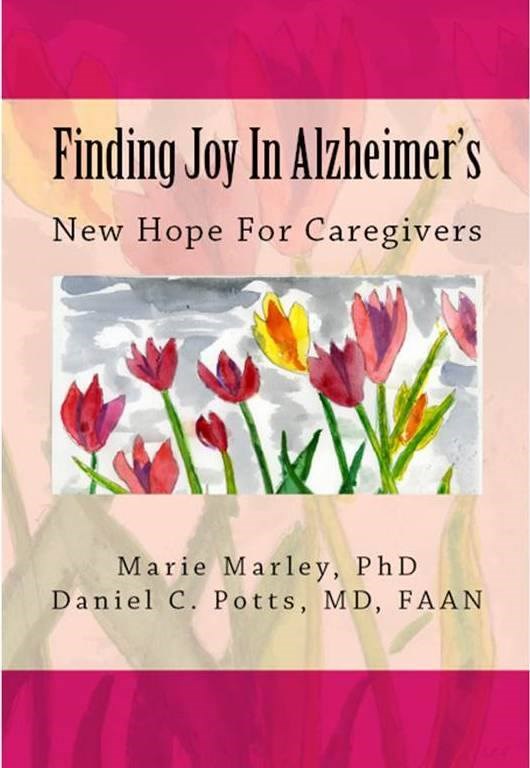 Three Ways to Encourage Your Own Love and Acceptance
Three Ways to Encourage Your Own Love and Acceptance
Here are a few excerpts from Daniel:
- Each interaction we have with another person presents an opportunity to share the hope that is within us.
- As care partners, we must identify and embrace the love present within each individual and we must enable the expression of that love, for personhood to be preserved and dignity promoted. We must also be fully cognizant of the love within ourselves.
- To come to terms with Alzheimer’s you must first let go of the expectation that you’ll find the previous person and instead embrace the new person– just as he is in the present. Since that person will continue changing as time goes by, one must constantly let go of the old person and accept the new one.
Three Ways to Improve Your Time Together
Marie offers these tips for staying connected:
- Use welcoming body language. Don’t sit with your arms crossed; sit with your palms turned upward. This posture says, “I’m receptive to you.”
- Speak slowly and in short, direct sentences, with only one idea to (in) each sentence.
- Laugh a lot. Arrive for your visit with a supply of simple jokes and funny stories.
For more information about Finding Joy in Alzheimer’s, visit ComeBackEarlyToday.com
Deborah Shouse is the author of Love in the Land of Dementia: Finding Hope in the Caregiver’s Journey.
Strengthen your Heart, Open Your Ears, and Ignite your Spirit with Conductorcise
Maestro David Dworkin moves his baton and a Strauss waltz begins. But instead of facing a sea of symphonic musicians, the auditorium is filled with people also holding batons, following the Maestro’s movements. They are engaged in the Maestro’s globally renowned exercise program, Conductorcise.
Click here for an exhilarating example: Conductorcise
As the music continues, two women begin to waltz in the aisle. Later, he learns that these women are living with dementia. “They haven’t moved in months,” a health care worker tells him.
At a memory care unit, he passes out batons, handing them even to people who seem slumped and unresponsive. He introduces John Phillip Sousa, offering a few tidbits about the composer. Then he starts a Sousa march and leads his group in vibrant upper body movements. Soon everyone, even three people who seemed oblivious, are conducting along with him.
Such is the power of movement and music.
Leading with Benefits
“The vibrations and energy of the music speak to people,” says Masetro Dworkin. “You benefit from relieving stress, building aerobic stamina, improving listening skills, and increasing social engagement while imagining yourself leading a symphony orchestra.”
As a bonus, you can learn a little about the lives and works of the great composers.
The program appeals to all ages and abilities and has spread around the world, from Holland to Canada to Singapore.
Conducting for Two or More
The program works wonderfully one-on-one.
“You can’t do anything wrong,” Maestro says. “You don’t even need a baton. You can use chopsticks, unsharpened pencils, a straw, or just your arms.”
Here are a few tips for enjoying Conductorcise:
- To get started, you might say, “How about helping me conduct this tune?”
- Select a familiar song your partner enjoys, one that might also inspire conversation and singing.
- Move your arms and upper body to the music and encourage your partner to move as she wishes. Move your lower body as well, if appropriate.
- For those who need extra support, add eye contact and gently stroke their arms.
- Invite friends and family members to join you.
“Everyone wants to be a conductor!” Maestro Dworkin says.
###
Visit http://www.conductorcise.com glean ideas from Maestro’s listening library and information about his training and certification programs.
Julliard-trained Maestro David Dworkin has led orchestras across the globe, and performed as clarinetist with ensembles internationally. He served as conductor and Artistic Consultant for three PBS Television documentaries in the series Grow Old With Me, and devoted much of his career to working with young people. In his 80’s, he has become a sought-after role model for all, demonstrating how exercise, music, joy and a positive outlook can create a healthy journey through life.
Deborah Shouse is the author of Love in the Land of Dementia: Finding Hope in the Caregiver’s Journey.
